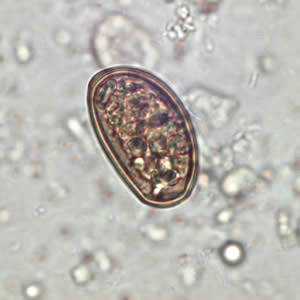Life Cycle
The Lancet liver fluke (Dicrocoelium dendriticum) has a rather complex life cycle that includes two intermediate hosts and one definitive host. The fluke’s two intermediate hosts most commonly are the land snail (i.e. Zebrina sp., Cionella sp.) and the field ant (i.e. Formica sp.) (CDC 2013). The definitive host is typically a ruminant (i.e. cows, sheep, goats), although it is possible for Dicrocoelium dendriticum to infect other organisms as well, such as human beings (Schweiger and Kuhn 2008).
The life cycle begins when a land snail, the first intermediate host, ingests the embryonated eggs of the parasite. After it reaches the intestine of the snail, the eggs hatch and release miracidia, or ciliated larvae..gif) This process of hatching and releasing only occurs in land snails that act as hosts (Manga-Gonzalez 2001). The miracidia then burrow through the intestinal wall and enters the hepatopancreas of its host, where they become sporocysts. Through asexual reproduction, the sporocysts create daughter sporocysts, which generate cercariae (Manga-Gonzalez 2001, Otranto and Traversa 2003). When mature, the cercariae travel to the respiratory tract of the snail where they are excreted in the form of slime balls (CDC 2013, Manga-Gonzalez 2001, Otranto and Traversa 2003).
This process of hatching and releasing only occurs in land snails that act as hosts (Manga-Gonzalez 2001). The miracidia then burrow through the intestinal wall and enters the hepatopancreas of its host, where they become sporocysts. Through asexual reproduction, the sporocysts create daughter sporocysts, which generate cercariae (Manga-Gonzalez 2001, Otranto and Traversa 2003). When mature, the cercariae travel to the respiratory tract of the snail where they are excreted in the form of slime balls (CDC 2013, Manga-Gonzalez 2001, Otranto and Traversa 2003).
Field ants consume these slime balls, making ants the second intermediate host of
Dicrocoelium dendriticum. After ingestion, the cercariae
transform into metacercariae inside the abdominal cavity, losing their tail in the process (Manga-Gonzalez 2001, Otranto and Traversa 2003). Further infecting the host, one---occasionally two or three---metacercariae make their way to the ant’s brain. When the temperature drops below approximately 15-20oC, the metacercariae in the host’s brain cause the ant to cramp or spasm and remain fixed on a plant, typically the flower, which makes ingestion of the infected organism easier (Duchacek and Lamka 2003, Manga-Gonzalez 2001, Otranto and Traversa 2003).
flower, which makes ingestion of the infected organism easier (Duchacek and Lamka 2003, Manga-Gonzalez 2001, Otranto and Traversa 2003).
After grazing ruminants ingest the infected ants, the mature metacercariae excyst in the new definitive host’s intestinal tract and travel through the biliary ducts, which is the center of metacercariae maturation into adult flukes (Duchacek and Lamka 2003, Manga-Gonzalez 2001, Otranto and Traversa 2003). Here, the adult fluke, which is hermaphroditic, produces eggs that are excreted through the host’s fecal matter (Manga-Gonzalez 2001, Otranto and Traversa 2003). Bringing the
Dicrocoelium dendriticum life cycle full circle, a land snail consumes the excreted eggs.